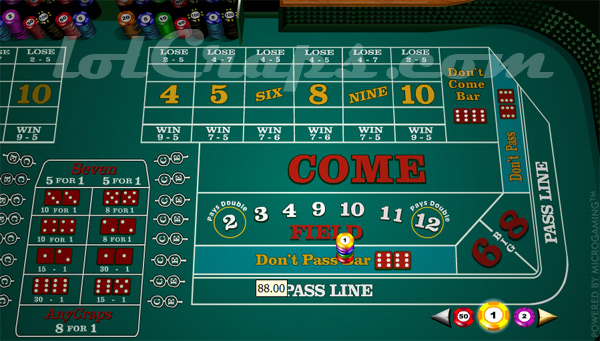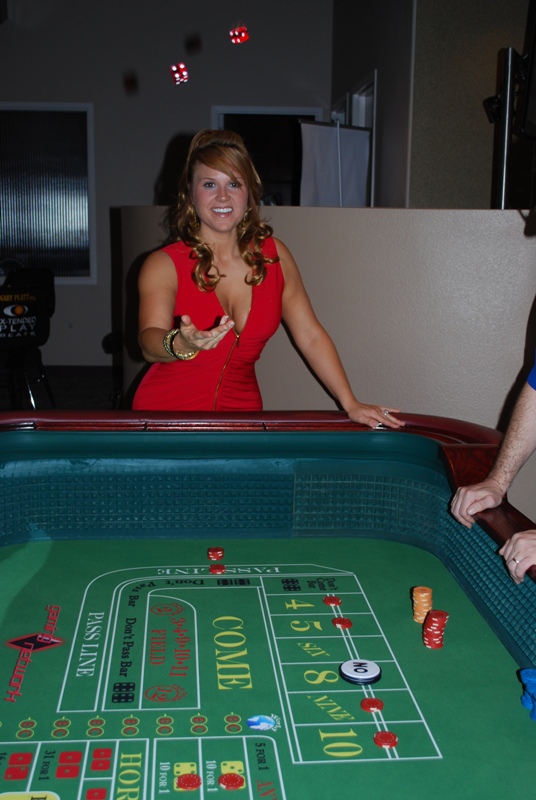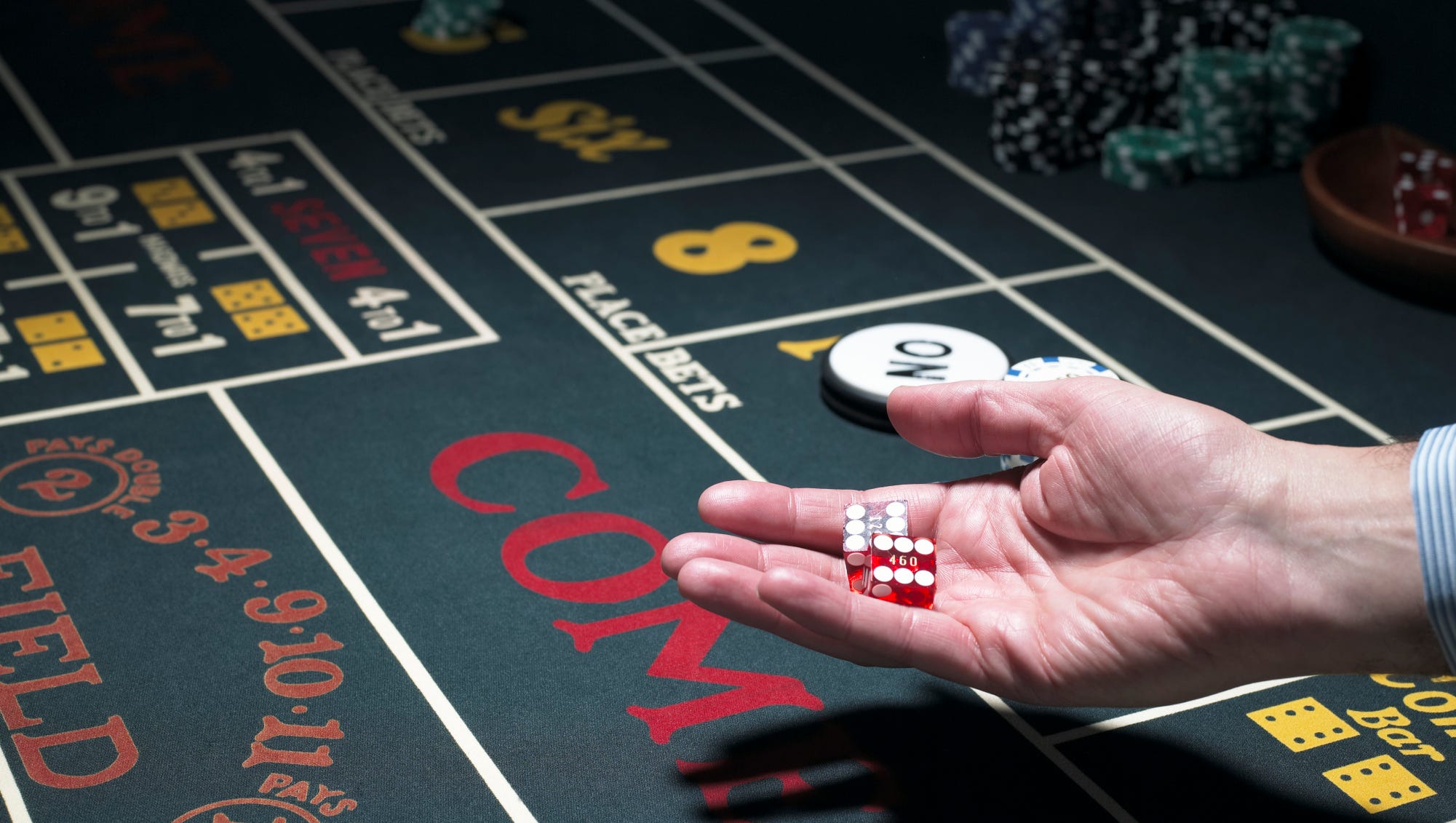Craps Don't Pass Line Bet
- Craps: The “Don’t Pass” Bet. Last update: September 2019. In the How to Play Craps article, we.
- This video covers a craps betting strategy called the Don't Pass and Don't Come for Beginners. It covers the placing a don't pass bet on the come out roll fo.
How to play craps video (part 4 of 5):: All you need to know about playing the don't side; SEP 1 Craps (version 2) - Part 3 of 5: Video for the new Craps tutorials, Sucker Bets. AUG 7 Vegas 2066: Fiction about a reclusive individual fifty years in the future and how the game of craps opens him up to the possibilities in the, 'Real world' JUL 29. The don't pass line bet used with maximum don't pass odds bet is the absolute best bet you can make in craps or anywhere else in the casino! This has slightly better odds than even the regular pass line bet used with pass odds, so it gives you the best mathematical odds possible.
Craps is a much easier game to learn than most people think. The basic premise is simple: you are betting on the outcome of the roll of two dice. The only thing that makes the game confusing is all the different types of bets you can place.
Most of these bets are straightforward, but it’s just the fact that there are so many of them that make the game a little complicated. You don’t need to know how each one works to enjoy playing the game, so it’s not like you have to learn them all before you start playing.
The bets we would say you absolutely must understand are the pass line and don’t pass wagers, the come and don’t come wagers, and the odds bets. We explain these in detail below, and also provide information on all the types of bets. Here is a list of the bets we discuss below:
- Pass Line & Don’t Pass Wagers
- Come & Don’t Come Bets
- Odds Bets
- Place Win
- Place Lose
- Buy
- Lay
- Big 6 and Big 8
- Hardways
- Field
- Proposition Bets
The pass line and don’t pass wagers are the most commonly placed bets in craps and also the most straightforward. A shooter will usually have to place one of them before making their come-out roll; and in some casinos, players must make one of them if they also want to place other wagers. These bets have to be placed before the come-out roll, and they both pay out at even money (1:1) when they win.
A pass line bet wins if the value of the come-out roll is 7 or 11 and loses if it’s 2, 3, or 12. If it’s any other value, then a point is established at that value, and the pass line wager remains on the table until the point is rolled again or 7 is rolled. If the point is rolled, the wager wins; if 7 is rolled, the wager loses.
Craps Don't Pass Line Bets
A don’t pass wager wins if the value of the come-out roll is 2 or 3 and loses if it is 7 or 11. If the value is 12, then the bet is pushed, neither winning nor losing. Just like the pass line bet, it remains on the table if a point is established. The don’t pass wager loses if the point is rolled again and wins if a 7 is rolled.
Come & Don’t Come Bets
These wagers are very similar to the pass line and don’t pass bets, the main difference being that they are placed after the point is established rather than before. They can be a little confusing, so please make sure you fully understand the concept before placing them.
If the first roll after you have placed a come bet is a 7 or 11, then you win your wager. If a 2, 3, or 12 is rolled, then you lose. If any other number is rolled, this is the point for your come wager. So if a 5 is rolled, for example, then 5 becomes your point. Your wager stays in place and will win if a 5 is rolled again, and lose if a 7 is rolled. A come bet may be thought of as a personalized pass line bet, where the point number is established on the first roll after it has been placed.
By the same token, a don’t come bet is like a personalized don’t pass bet. It will lose if a 7 or 11 comes up on the first roll after you place it, and win if a 2 or 3 is rolled. Any other number establishes the point for your don’t come wager, which will then stay in place until it either wins or loses. It will win if a 7 is rolled, and lose if the point is rolled.
Both of these bets are paid out at even money (1:1) when they win.
Odds bets are a bit like side bets that can be made after a point is established. They are essentially extensions of each of the four bets mentioned above. There are four different types:
Craps Pass Bet
- Pass Line Odds
- Don’t Pass Odds
- Come Odds
- Don’t Come Odds
You would place a pass line odds bet to complement your pass line bet following a point being established. It pays if the point is then rolled before a seven, and loses if a seven is rolled. The big advantage of this type of bet is that it’s paid out at true odds when it wins i.e. there’s no house edge. The payouts vary, depending on what the point is.
When you place a pass line odds bet, you are said to be “taking the odds.” Because there’s no house edge, the amount you can stake is limited. Typically, you can stake up to three times the amount on your original pass line wager, but some casinos allow more.
A don’t pass odds bet is placed to complement a don’t pass bet. It pays if a seven is rolled before the point, and loses if the point is rolled first. Bets of this type are also paid out at true odds with no house edge and, again, the payouts vary depending on what the point is.
| Point | Payout |
| 4 or 10 | 1:2 |
| 5 or 9 | 2:3 |
| 6 or 8 | 5:6 |
You are said to be “laying the odds” if you place a don’t pass odds bet. The amount you can stake is limited in the same way as a pass line odds bet. Come odds and don’t come odds bets are based on exactly the same principle. They just use the point that is established following a come or don’t come bet.

Place win bets can be made after a come-out roll when a point has been established. They can be on any of the numbers 4, 5, 6, 8, 9 or 10, and they win if the number chosen is rolled before a 7. The payouts vary depending on which number you have chosen.


| Number Choosen | Payout |
| 6 or 8 | 7:6 |
| 5 or 9 | 7:5 |
| 4 or10 | 9:5 |
These are basically the opposite of place win bets. They can be on the same choice of numbers (4, 5, 6, 8, 9, 10), but with a place lose, you win if a 7 is rolled before the number you have chosen. The payouts again vary depending on which number is chosen.
| Number Choosen | Payout |
| 6 or 8 | 4:5 |
| 5 or 9 | 5:8 |
| 4 or10 | 5:11 |
A buy bet is largely the same as a place win in that you are betting on a specific number to be rolled before a 7. The difference is that the payouts are higher, with the trade-off that you have to pay a 5% commission. At some casinos, this commission is payable when you place your stake, and at others it’s only payable if you win. The payouts once again vary based on which number has been chosen.
| Number Choosen | Payout |
| 6 or 8 | 6:5 |
| 5 or 9 | 3:2 |
| 4 or10 | 2:1 |
A lay bet is the opposite of a buy bet, and also comes with a 5% commission. With this wager, you are betting on a 7 being rolled before a specific number, in the same way as a place lose. It offers higher payouts than a place lose, which vary depending on the number chosen.

| Number Chosen | Payout |
| 6 or 8 | 5:6 |
| 5 or 9 | 2:3 |
| 4 or 10 | 1:2 |
These bets are very straightforward, and both pay even money (1:1) if successful. A big 6 wins if any 6 is thrown before a 7, and a big 8 wins if any 8 is thrown before a 7.
Hardways
When a number is rolled as a double, it’s said to have been rolled the hard way. A hard 8, for example, is a double 4. That is how wagers of this type get their names. They are pretty simple and are based on certain doubles being rolled before a 7.
You can bet on any of a hard 4, a hard 6, a hard 8, or a hard 10. If the relevant hard number is rolled before a 7, you win the bet. As with some other wagers, the payouts are determined by the number bet on.
Field
A field bet is always settled on the next roll. It will win if a 2, 3, 4, 9, 10, 11, or 12 is rolled and lose if 5, 6, 7, or 8 is rolled. It pays 1:1 unless a 2 or 12 is rolled, in which case it pays double (2:1).
There are several different proposition bets available in craps, all of which are settled on the next roll. We explain each of these below.
It’s worth mentioning that proposition bets come with higher payouts than previously mentioned options. The house edge is also higher, however, and players are generally advised to avoid them for this reason. However, there’s nothing wrong with using them if you’re willing to accept more risk in exchange for potentially bigger rewards.
- Any 7 (Payout 4:1). Wins if 7 is rolled next.
- Any 11 (Payout 15:1). Wins if 11 is rolled next.
- Any Craps (Payout 7:1). Wins if any of 2, 3 or 12 is rolled next.
- Ace Deuce (Payout 15:1). Wins if 3 is rolled next.
- Aces (Payout 30:1). Wins if 2 is rolled next.
- Boxcar (Payout 30:1). Wins if 12 is rolled next.
The Best Bets In Craps: Pass/Come and Dont Pass/Dont Come
By Jerry 'Stickman'
The game of craps can be very exciting. It can also be very frustrating. One of the great draws to this game is the variety of bets available. One can bet with the shooter betting that he will make the point number before the 7 shows, or one can bet that the 7 will rear its ugly head before the shooter repeats the point number.
Of course, there are dozens of other bets also available; place bets, hard way bets, field bets, horn bets, whirl bets, hop bets, big 6, big 8 and big red. Each bet comes with its own probability of hitting, payback amount and related house edge.
Two of the very best bets on the table are the pass line / come bets (with the shooter), and the dont pass / dont come bets (against the shooter). Both of these bets have about a 1.4 percent house edge, but obviously pay at different times.
A pass line on come-out (before a point is set) wins if a 7 or 11 is tossed and loses when a 2, 3, or 12 appears. If any other number is thrown, that number becomes the point and the come-out cycle is over for the pass line bet. The point numbers (sometimes called box numbers because they are the numbers in the 'boxes' by the dealers) are 4, 5, 6, 8, 9, and 10.
The come bet works just like the pass line bet, but it is placed when a point is already established for the pass line. The player places the bet in the Come area. If a 7 or 11 appears, the bet wins. If a 2, 3, or 12 appears, the come bet loses. If any other number is rolled, the come bet is moved inside the square by the dealer that contains that number. The point is now established and the come-out cycle is over for that come bet.
If a 7 is rolled when there is a come bet in the Come area, the come bet wins but the pass line and any come bets that have already been moved to a point number lose.
The power of pass / come bets is realized during the come out phase. It wins on a 7 or 11 and loses on a 2, 3, or 12. There are six ways to make a 7 (1-6, 6-1, 2-5, 5-2, 3-4, 4-3) and two ways to make an 11 (5-6, 6-5) for a total of eight ways to win. There is one way to make a 2 (1-1), two ways to make a 3 (1-2, 2-1) and one way to make a 12 (6-6) for a total of four ways to lose. That is a 2-to-1 advantage. Once a point is established, however, the advatage swings solidly toward to house.
The dont pass/dont come works similar to the pass/come bet, however, you are betting the opposite way. On come-out, a dont pass / dont come loses if a 7 or 11 is thrown and wins if a 2 or 3 is rolled. If this bet were truly the opposite of the pass/come bet, the player would have an edge, so in order to tip the scales toward the house, the 12 appearing on come-out is a push no one wins or loses. This one minor change is enough to swing the edge toward the house.

The edge is solidly with the house on the come-out with dont pass/dont come bets. There are 8 ways to lose and only 3 ways to win, however , once you make it past the come-out, the edge favors the player.
Once a point is established, the pass/come, dont pass/dont come player can add odds behind initial (flat) bet. This is called placing odds for the pass/come bet and laying odds for the dont pass/dont come bet. On a win, the flat portion of the bet is paid even money and the odds are paid at true odds. For example, the odds of throwing a 4 before a 7 is 2-to-1. For a point of 4 the odds behind a pass or come bet are paid at 2 units for every unit bet. For dont pass/dont come the odds are 1-to-2 that the 7 will appear before the 4, so the odds are paid at 1 unit for each 2 unit laid.
The flat portion of pass/come bets are considered 'contract' bets after the point is established. This means that the flat portion cannot be removed or reduced once the point is established. It can be increased however. The odds can be increased, decreased or removed at anytime.
Dont pass / dont come bets can be removed at any time since the player has the edge on these bets.
As stated previously, the house edge for pass/come, dont pass/dont come bets is about 1.4 percent. Because the odds bets are paid at true odds, there is no house edge on the odds portion. By adding single odds (equal to the flat bet), the edge drops to .83 percent. At double odds it drops to .61% and at 5 times odds it drops to paltry 1/3 of one percent. This is why the pass/come and dont pass/dont come bets are the best in the game of craps.
Stick with this betting and your winning session will increase and the amount you lose will decrease. It is in the math.
May all your wins be swift and large and all your losses slow and tiny.
Jerry 'Stickman' is an expert in craps, blackjack and video poker and advantage slot machine play. He is a regular contributor to top gaming magazines. The 'Stickman' is also a certified instructor for Golden Touch Craps and Golden Touch Blackjack. For more information visit www.goldentouchcraps.com or www.goldentouchblackjack.com or call 1-886-738-3423. You can contact Jerry 'Stickman' at stickmanGTC@aol.com